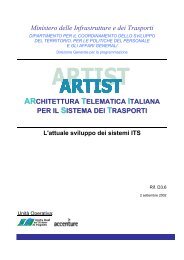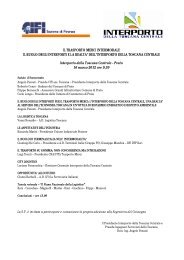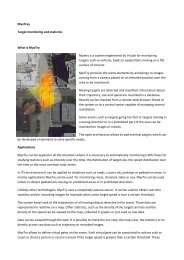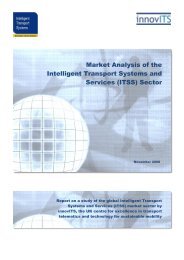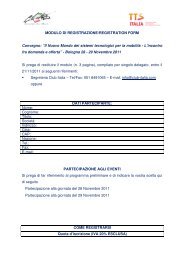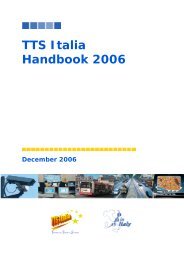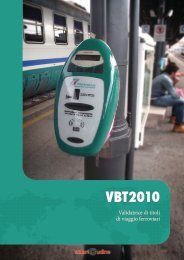ITS for Developing Countries ITS for Developing Countries - TTS Italia
ITS for Developing Countries ITS for Developing Countries - TTS Italia
ITS for Developing Countries ITS for Developing Countries - TTS Italia
Create successful ePaper yourself
Turn your PDF publications into a flip-book with our unique Google optimized e-Paper software.
1<br />
<strong>ITS</strong> Technical Note<br />
introduction of technologies like <strong>ITS</strong>.<br />
In both developed and developing countries, innovative<br />
strategies <strong>for</strong> the deployment of transportation infrastructure<br />
have often taken the <strong>for</strong>m of public-private partnerships.<br />
One common model <strong>for</strong> public-private cooperation in<br />
infrastructure development and operation is called BOT (<strong>for</strong><br />
Build, Operate, Transfer). In this model, private companies<br />
invest in the construction of infrastructure and, with public<br />
sector support, own and operate the infrastructure and<br />
collect tolls or usage fees. Once the investment has been<br />
recouped, the facility is transferred to the public sector <strong>for</strong><br />
continuing operation.<br />
Other potential areas <strong>for</strong> public-private partnerships include:<br />
•Road asset management and maintenance through public<br />
sector concessions to private companies<br />
•Cooperative ef<strong>for</strong>ts to gather, assemble, and distribute<br />
traveler in<strong>for</strong>mation<br />
•Private sector participation in the administration and<br />
execution of wide-area road pricing<br />
•Public encouragement of the freight hauling industry in<br />
countries where this industry is not well developed<br />
In most cases, it is not only the transportation system which<br />
benefits from this cooperation. Public-private partnerships<br />
in surface transportation can also have a beneficial effect<br />
on the entire economy both through the improvement of<br />
transportation resources and their management and by<br />
stimulating industry and commerce. <strong>ITS</strong> also helps these<br />
cooperative activities to function better by improving<br />
in<strong>for</strong>mation flow and by providing better management tools.<br />
<strong>ITS</strong> helps facilitate the administration of cooperative publicprivate<br />
activities and helps the parties communicate better<br />
and more effectively with each other and with the public.<br />
For public-private partnerships to be successful, both sides<br />
must contribute to the partnership and both sides must<br />
benefit from its activities. Some important issues are:<br />
•Responsibilities of each partner must be clearly stated and<br />
agreed on<br />
•Respective contributions of money, materials, and ef<strong>for</strong>t<br />
must be clearly defined<br />
•Contributions, use, and final ownership of intellectual<br />
property must be agreed on<br />
•A joint decision-making process and a joint progress review<br />
and acceptance process must be in place<br />
•As with any major undertaking, deliverables and schedules<br />
must be clearly defined<br />
Each partner may have to make some adjustments in the<br />
way it does business. Public sector partners need to seek<br />
ways to reduce administrative and bureaucratic overhead<br />
and streamline their decision making and procurement<br />
process. Private sector partners may need to introduce<br />
additional measures to assure accountability and process<br />
visibility where the use of public funds is concerned.<br />
By addressing these issues and finding ways to work<br />
cooperatively together, the participants in a public-private<br />
partnership can all benefit from the resulting synergies.<br />
4 Summary<br />
This introductory <strong>ITS</strong> Technical Note 1 has tried to<br />
demonstrate that Intelligent Transport Systems (<strong>ITS</strong>) are an<br />
important component in the development of future<br />
transportation systems in developing countries.<br />
<strong>ITS</strong> offers the potential <strong>for</strong> significant society-wide benefits.<br />
The benefits of <strong>ITS</strong> providing society-wide benefits include:<br />
•Improved mobility <strong>for</strong> people and freight, including greater<br />
access to transportation <strong>for</strong> the elderly, the disabled, and<br />
people living in remote locations<br />
•Less traffic congestion<br />
•Greater compatibility of surface transportation with the<br />
environment<br />
•Fewer traffic-related deaths and injuries<br />
•A better-managed transportation system<br />
<strong>ITS</strong> also offers a wide range of immediate and tangible<br />
benefits to the people who operate and use the transportation<br />
system by adding stability, visibility, in<strong>for</strong>mation, and control.<br />
The benefits of <strong>ITS</strong> enhancing reliability and business<br />
efficiency include:<br />
•Less travel uncertainty, allowing <strong>for</strong> better planned, quicker,<br />
and less expensive travel<br />
•Better security <strong>for</strong> freight movement and travelers<br />
•Increased efficiency <strong>for</strong> transportation system operators<br />
•Increased efficiency <strong>for</strong> users of the transportation system,<br />
including travelers, shippers, and freight carriers<br />
By helping to deploy technology in the marketplace, <strong>ITS</strong> also<br />
provides a variety of general benefits that are related to<br />
improvements in the in<strong>for</strong>mation infrastructure and may not<br />
be specifically related to transportation:<br />
•Encouraging movement toward a “Knowledge Economy”<br />
•Helping to fostering the IT industry<br />
•Assisting integration of public agencies and regions<br />
•Promoting greater general dissemination of IT<br />
Introducing <strong>ITS</strong> in developing countries has special<br />
challenges and constraints, but also special opportunities.<br />
These special opportunities allow developing countries to<br />
leapfrog to an <strong>ITS</strong>-enabled transportation system more<br />
rapidly than developed countries and at lower cost. These<br />
include the opportunity to deploy <strong>ITS</strong> in the infrastructure<br />
at the same time that the physical infrastructure is being<br />
built, the opportunity to make use of mature <strong>ITS</strong> applications<br />
developed and tested in developed countries, and the<br />
opportunity to leverage the simultaneous spread of other<br />
technology networks like cellular and the Internet.<br />
Successful leapfrogging to an <strong>ITS</strong>-enabled transportation<br />
system depends on a number of principles. <strong>ITS</strong> should be:<br />
•Demand-driven, so that <strong>ITS</strong> introduction meet real user<br />
needs.<br />
•Af<strong>for</strong>dable, using the appropriate level of technology,<br />
focusing on projects with the greatest return on investment,<br />
and making good use, wherever possible, of the experience<br />
of other countries.<br />
14



